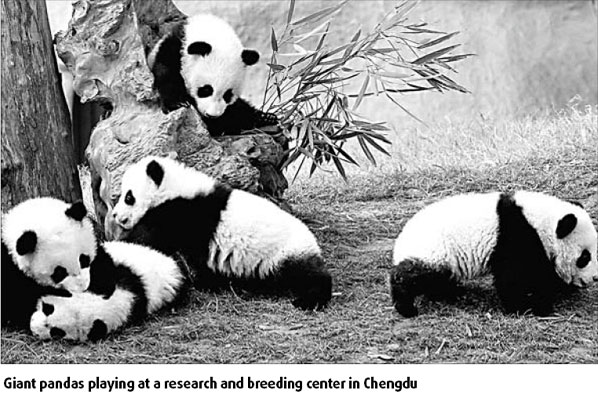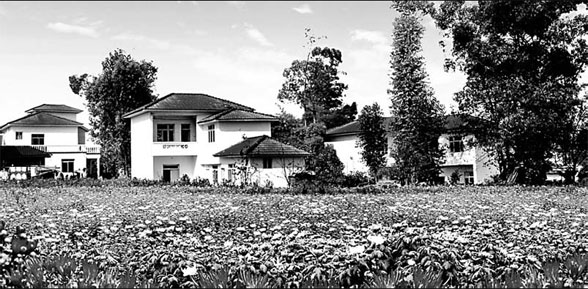Special supplement: Chengdu looks to bridge urban-rural growth gap
|
A new countryside in Chengdu. The city has been designated as a national pilot area for reforms to lessen the disparity between urban and rural economies. |
Home to the giant panda and birthplace of Taoism, Chengdu is also a bustling city now trying to strike a balance between urban and rural development.
The metropolis in southwest China has more than 6 million rural residents, nearly 55 percent of its total population.
Like other Chinese cities, Chengdu faces the problem of a sharp contrast in per capita disposable income between urban and rural residents, as well as in public services like education and medical care. In general, rural development lags far behind urban areas.
Beginning in 2003, the city government began a series of reforms to tackle the problem and advance urban-rural integration.
To reduce the disparity between residents, attracting investment remains a priority on the local government's agenda.
With most investment projects drawn to favorable policies in development zones, usually located in the suburbs, rising investment in the city itself has absorbed much of the surplus rural labor and at the same time advanced urban expansion and growth in the service sector, which is expected to create jobs for rural residents and increase their incomes.
A growing number of farmers switching from farmland to construction work in the city is also resulting in the consolidation of land into larger farms. Those who choose to stay and farm are encouraged to use modern agricultural techniques, manage more land and increase productivity by using advanced technology and equipment.
More business opportunities have in turn been created in the city to meet the needs of migrant workers from the countryside, further invigorating the city's development.
Statistics show that Chengdu's gross domestic product continues to grow rapidly, increasing more than 13 percent annually in recent years to 332.44 billion yuan in 2007
The annual increase in urbanization has averaged 2 percent over the past five years, with the average income of both urban and rural residents rising about 10 percent over the same period.
The city was designated by the central government as a national pilot area for reforms to bridge the economic and social gaps between urban and rural regions in June 2007. Chengdu's development model, if successful, will be used across the entire country.
Investment attraction
Balanced development has significantly enhanced the image of Chengdu and made it a popular investment destination.
More than 40 colleges and universities and 2,700 research institutes with a total of 750,000 technicians and researchers in various fields are another appeal for investors.
With such rich human resources, Chengdu, a model city for intellectual property protection in the country, boasts that its locals now have increased awareness of and respect for intellectual property rights (IPR).
The first intellectual property court in the western region of China is part of Chengdu Intermediate People's Court, illustrating the city's efforts to provide a friendly climate for IPR protection.
The city government has also streamlined its approval procedures and improved the efficiency of administrative services to facilitate investment projects.
With well-established infrastructure, abundant human resources and improved administrative services, the dynamic southwestern city has become a hot spot for investment.
The number of foreign-invested companies in Chengdu rose to 4,462 by the end of 2007, of which 124 are Fortune-500 companies.
Recent years saw average annual profit of foreign-invested companies rising more than 30 percent.
Chengdu is listed as one of the 10-best business cities in the country and ranks at the top of all Chinese cities for saving business costs, according to Fortune China, in a nationwide survey released in October 2007.
It was also designated as a model city last November by the National Development and Reform Commission and the World Bank for its investment environment.
Burgeoning tourism
Known as the "Land of Affluence", Chengchu is endowed with mild climate and picturesque natural landscape. It now has 20 scenic spots, forest parks and natural reserves developed by the city.
Renowned as the home of the giant panda, the national treasure of China, the city has a panda research and breeding center and four panda nature reserves to protect a vast native habitat of the panda.
With more than 3,000 years of history, Chengdu is also rich in historical heritage.
It has 17 national-level historic sites, including a shrine to Zhuge Liang, premier of the Shu Kingdom during the Three Kingdoms (AD 220-280) - Shu is the ancient name for Sichuan - and the residence of Du Fu, a renowned poet during the Tang Dynasty (AD 618-907) who lived for a time in Chengdu.
A great number of ancient gold, copper, stone, jade and pottery artifacts have been found in the famous Sanxingdui archeological site 38 km south of urban Chengdu.
The archeological discovery, extolled by residents as the eighth wonder of the world, offers a glimpse into the splendid ancient Shu civilization on Chengdu Plain, which can be traced back 5,000 years.
The discovery of the Jinsha archeological site reinforces Chengdu's historical importance. Elegant cultural relics excavated from the site show that Jinsha was a major center of the ancient Shu civilization about 3,000 years ago, experts said.
Included in the ancient artifacts discovered are a round gold disk with a windmill-edged inner circle and a hollow four-bird design that looks like a fine paper-cut handicraft.
According to ancient Chinese beliefs, 10 giant birds take turns carrying the sun every day. Archeologists say the golden disk is a reflection of sun worship by the Shu civilization, a belief held in common with ancient Greek worship of Apollo and Aztec deification of the sun.
The sunbird design has been designated by the State Administration of Cultural Heritage as a logo for Chinese cultural heritage.
The Dujiangyan Weir in Chengdu, an ancient water project built more than 2,200 years ago, is still in use today. Its advanced design continues to surprise visitors from home and abroad.
Listed as a World Heritage Site in 2000, the irrigation project makes full use of local geology, causing little environmental damage.
Qingcheng Mountain, where Taoism originated, is also in Chengdu. Well-preserved Taoist buildings, stone inscriptions of poems and essays, and ancient statues in the dense forest make for a fairyland atmosphere at the Taoism shrine.
The China National Tourism Administration and the United Nations World Tourism Organization jointly named Chengdu as one of the three-best tourist destinations in China in February 2007. The other two cities are Dalian in northeast China and Hangzhou in east China.

(China Daily 03/12/2008 page16)















